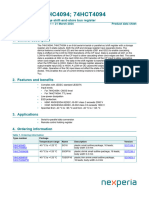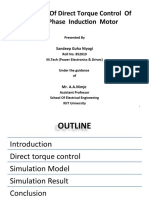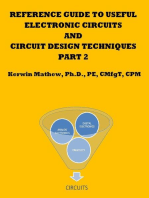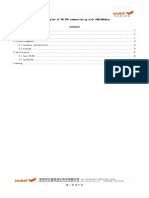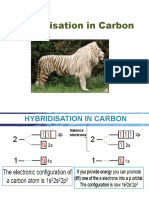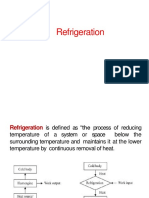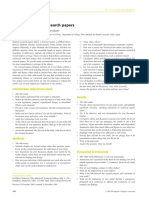CIENTIFICO3
CIENTIFICO3
Uploaded by
Carlos CastroCopyright:
Available Formats
CIENTIFICO3
CIENTIFICO3
Uploaded by
Carlos CastroCopyright
Available Formats
Share this document
Did you find this document useful?
Is this content inappropriate?
Copyright:
Available Formats
CIENTIFICO3
CIENTIFICO3
Uploaded by
Carlos CastroCopyright:
Available Formats
High Voltage DC Transmission Systems
POWER SYSTEM MODELLING AND CONTROL (EEEN40550)
Prof. Federico Milano
Email: federico.milano@ucd.ie
Tel.: 01 716 1844
Room 157a – Engineering & Materials Science Centre
School of Electrical & Electronic Engineering
University College Dublin
Dublin, Ireland
Dublin, 2022 High Voltage DC Transmission Systems - 1
Outlines
• Basic structure and operation.
• Commutation.
• Harmonics.
• Typical DC links.
• Controls.
• Fundamental frequency, reduced model.
• Steady state model.
Dublin, 2022 High Voltage DC Transmission Systems - 2
Basic Structure and Operation (I)
• AC voltages are first converted into dc, the power is then transmitted on a high voltage
dc line, and finally converted again into ac at the other side of the HVDC link.
AC transfs. AC transfs.
AC AC filters AC/DC DC filters Transmission DC filters DC/AC AC filters AC
system Protections Protections system
Converter Protections Line Protections Converter
1 Reactive Reactive 2
Power Power
Converter Converter
Controls Controls
System
Control
Dublin, 2022 High Voltage DC Transmission Systems - 3
Basic Structure and Operation (II)
• AC/DC 6-pulse converter.
Cathode
1 3 5 1 3 5 +
R S R S
Vdc
T T
4 6 2 4 6 2 −
Anode
1 3 5 1 3 5
R S R S
T T
4 6 2 4 6 2
1 3 5 1 3 5
R S R S
T T
4 6 2 4 6 2
on off
T5 R1 S3 T5 R1 S3 T5 R1
Cathode
Neutral
Anode
S6 T2 R4 S6 T2 R4 S6 T2
Dublin, 2022 High Voltage DC Transmission Systems - 4
Basic Structure and Operation (III)
• This results on Vdc voltage:
5&6 1&2 3&4 5&6
6&1 2&3 4&5 6&1
vdc
• Each “valve” is on for 120◦ .
Dublin, 2022 High Voltage DC Transmission Systems - 5
Basic Structure and Operation (IV)
• Using thyristor valves in the converter:
Anode
id
+
vd
−
+
vg
−
Cathode
• on ⇒ vd > 0 & vg > 0
• off ⇒ id < 0
Dublin, 2022 High Voltage DC Transmission Systems - 6
Basic Structure and Operation (V)
• For firing delay angle 0 < α < 90◦ (rectifier, i.e., vdc > 0):
T5 R1 S3 T5 R1 S3 T5 R1
Cathode
α
Neutral
Anode
S6 T2 R4 S6 T2 R4 S6 T2
T S RS RT ST SR T R T S RS RT ST SR T R
Reference
vdc anode busbar
Dublin, 2022 High Voltage DC Transmission Systems - 7
Basic Structure and Operation (VI)
• For firing delay angle α = 90◦ , vdc = 0:
T5 R1 S3 T5 R1 S3 T5 R1
Cathode
Neutral
Anode
S6 T2 R4 S6 T2 R4 S6 T2
α = 90◦
T S RS RT ST SR T R T S RS RT ST SR T R
Reference
vdc = 0 anode busbar
Dublin, 2022 High Voltage DC Transmission Systems - 8
Basic Structure and Operation (VII)
• For firing delay angle α = 180◦ , (inverter, i.e., vdc < 0):
T5 R1 S3 T5 R1 S3 T5 R1
Cathode
Neutral
Anode
S6 T2 R4 S6 T2 R4 S6 T2
α = 180◦
T S RS RT ST SR T R T S RS RT ST SR T R
Reference
anode busbar
vdc
Dublin, 2022 High Voltage DC Transmission Systems - 9
Commutation (I)
• The transformer reactance xc and the constant current lead to commutation problems:
β
1 idc = const.
vc,S vc,R vc,T
+ xc,R +
i1
ic
vc,R α
xc,S 3 vdc µ
+ idc = const.
vc,S i1 i3
− − i3 − neutral
Dublin, 2022 High Voltage DC Transmission Systems - 10
Commutation (II)
• Effect of commutation on voltages and currents.
T S RS RT ST SR T R T S RS RT ST SR T R T S
vdc
i5 i1 i3 i5 i1 i3 i5 i1 Thyristor 1
idc current
i6 i2 i4 i6 i2 i4 i6 i2
idc
i1 i1 i1 Phase R
iR current
−i4 −i4
Dublin, 2022 High Voltage DC Transmission Systems - 11
Commutation (III)
• Definitions:
◦ α Firing angle
◦ µ Overlap angle
◦ β On angle
◦ γ Extinction angle:
γ = 180◦ − α − µ
• The value of angle γ is associated with the valve extinction angle , i.e. the time these
valves have to turn off.
• Commutation problems or “failures” may occur in inverters when the value of α is
large, i.e., γ is small, as there is not enough time for the valves to turn off.
• Hence, inverter controls are designed to keep γ > γmin ≈ 10◦ .
Dublin, 2022 High Voltage DC Transmission Systems - 12
Harmonics (I)
• As Idc is constant, the ac current has large harmonic content, as previously shown.
• This can be reduced by connecting in series two phase-shifter 6-pulse converters:
dc line
T1
ac grid
T2
Dublin, 2022 High Voltage DC Transmission Systems - 13
Harmonics (II)
• iac = iT 1 + iT 2
−π −π/2 idc π/2 π
iT 1
√
√ 2idc / 3
idc / 3
iT 2
√
idc / 3 π/3
idc
√ 2π/3
idc / 3 π/2
−π −π/2 0 π
iac
Dublin, 2022 High Voltage DC Transmission Systems - 14
Harmonics (III)
• The harmonic content in this signal is reduced by eliminating the 5th and 7th
harmonics:
1
2 3
amp · √
π
0
1 11 13 23 25
harmonic #
Dublin, 2022 High Voltage DC Transmission Systems - 15
Harmonics (IV)
• Harmonics in the ac and dc side are reduced by introducing filters:
dc line
6th 12th High Pass
ac grid
Dublin, 2022 High Voltage DC Transmission Systems - 16
DC Links
• Bipolar (e.g. Nelson River, Manitoba, Bipole 1, ±450 kV, 1620 MW, 1972 & 1977;
Bipole 2, ±500 kV, 1800 MW, 1978 & 1985):
• More terminals can be added leading to Multi-terminal HVDC links (e.g. Quebec-New
England, ±450 kV, 2000 MW, at least 3 terminals, 1990).
• Monopolar underwater connections (e.g. Moyle, link between Auchencrosh, South
Ayrshire in Scotland and Ballycronan More, County Antrim in Northern Ireland, Italy,
275 kV, 500 MW, 2001). Bipolar connections are preferred nowadays for technical and
environmental reasons.
• Multiterminal monopolar connections (e.g. SACOI, Sardinia-Corsica-Italy, 200 kV, 200
MW, 2012).
• Back-to-back (e.g. connection between Finnish and Russian high voltage systems,
Vyborg, 12-pulse, ±85 kV, 1420 MW, 1980-2001).
Dublin, 2022 High Voltage DC Transmission Systems - 17
DC Links in Europe
Source: http://en.wikipedia.org/wiki/File:HVDC_Europe.svg
Dublin, 2022 High Voltage DC Transmission Systems - 18
Model of a Standard 6-pulse HVDC Link
• Let consider the following scheme:
s̄h iR,dc = −iI,dc s̄k
+ +
vR,dc vI,dc
− −
1 : mR mI : 1 v̄k
v̄h
Rectifier Inverter
• Large inductors are used to make the dc current constant.
Dublin, 2022 High Voltage DC Transmission Systems - 19
Bases and Per Unit System (I)
• Ac/dc devices not only separates the ac grid side from the dc one.
• They also fully separate the ac quantities and bases from dc ones.
• In the following, dc bases are considered fully decoupled from ac ones and base
conversions are taken into account in the equations of ac/dc devices.
ac ac
• All ac quantities are in pu with respect to ac bases, i.e., Vbase and Sbase , and all dc
dc dc
quantities are in pu with respect to dc bases, i.e., Vbase and Ibase .
Dublin, 2022 High Voltage DC Transmission Systems - 20
Bases and Per Unit System (II)
• The following bases define the dc per unit quantities:
√
dc 3 2 ac
Vbase = Vbase
π
dc dc
Ibase = Irate = Indc
dc dc dc
Sbase = Vbase Ibase
dc dc dc
Rbase = Vbase /Ibase
ac
• Furthermore, Sbase = Sn ≈ Vndc Indc = Sbase
dc
holds to avoid inconsistencies.
Dublin, 2022 High Voltage DC Transmission Systems - 21
Rectifier Model (I)
• The rectifier scheme with current and voltage sign notation is shown below.
ph + jqh iR,dc
+
vR,dc
−
vh ∠θh 1 : mR
α
Dublin, 2022 High Voltage DC Transmission Systems - 22
Rectifier Model (II)
• The active and reactive power injections at the ac-side are:
ph = −k̂s vR,dc iR,dc (1)
qh = −k̂s k̂v mR vh iR,dc sin φh
• Where φh is the angle between the average ac voltage and the ac current of the
rectifier, mR is the transformer tap ratio, and:
dc
Sbase
k̂s = ac (2)
Sbase
√ ac
2 Vbase
k̂v = 0.9995 · 3 dc
(3)
π Vbase
Dublin, 2022 High Voltage DC Transmission Systems - 23
Rectifier Model (III)
• The link between the ac and the dc sides is given by:
0 = k̂v mR vh cos α − k̂ω xR,c iR,dc − vR,dc (4)
0 = k̂v mR vh cos φh − vR,dc
where α is the firing angle of the rectifier and
ac
3 Zbase
k̂ω = dc
(5)
π Rbase
• Two additional equations are required to complete the converter model. These
equations model the controllers of the transformer tap ratio mR and the firing angle α
Dublin, 2022 High Voltage DC Transmission Systems - 24
Inverter Model (I)
• The inverter scheme with current and voltage sign notation is shown below.
iI,dc pk + jqk
+
vI,dc
−
mI : 1 vk ∠θk
γ
Dublin, 2022 High Voltage DC Transmission Systems - 25
Inverter Model (II)
• Equations (1) and (4) have to be rewritten to take into account the extinction angle or
commutation margin γ and the sign of the dc current on the inverter dc side.
• For the two-terminal scheme above: iI,dc = −iR,dc , hence one has:
pk = −k̂s vI,dc iI,dc (6)
qk = k̂s k̂v mI vk iI,dc sin φk
0 = k̂v mI vk cos(π − γ) − k̂ω xI,c iI,dc + vI,dc
0 = k̂v mI vk cos φk − vI,dc
where φk is the angle between the ac voltage and the ac current of the inverter.
Dublin, 2022 High Voltage DC Transmission Systems - 26
Inverter Model (III)
• Since iI,dc < 0, the inverter injects active power and consumes reactive power at the
ac bus k .
• Observe that the ac power and voltage bases (as well as the system frequency) have
not to be necessarily the same as those used for recitifier ac-side quantities.
• As for the rectifier, two equations are required to complete the model. These equations
model the controllers of the transformer tap ratio mI and the extinction angle γ .
Dublin, 2022 High Voltage DC Transmission Systems - 27
HVDC Control
• HVDC controllers have to coordinate the operations of the rectifier and the inverter
devices.
• The controlling variables are the transformer tap ratio and the firing angle on the
rectifier side and the transformer tap ratio and the extinction angle on the inverter side.
• Tap ratio controls are necessarily slower than those of firing/extinction angles.
• The firing and extinction angles, which are characterized by fast dynamics, are
considered algebraic variables, while the tap ratio, whose dynamic is relatively slow,
are considered state variables.
Dublin, 2022 High Voltage DC Transmission Systems - 28
Rectifier Current Control Mode (RCCM)
• Rectifier-side regulators control the dc current idc through a PI controller that varies
the firing angle α, and the ac voltage vh through the off-nominal tap ratio mR .
• Inverter-side regulators maintain constant the extinction angle γ = γ ref ≥ γ min and
control the dc voltage vI,dc through the tap ratio mI .
• The DAE system is as follows:
ref
ṁR = (vh − vac )/TR (7)
ref
ṁI = (vdc − vI,dc )/TI
ẋR,α = Ki (iref
dc − idc )
0 = xR,α + Kp (iref
dc − idc ) − α
0 = γ ref − γ
• The PI control undergoes an anti-windup limiter in order to maintain the firing angle
within its limits.
Dublin, 2022 High Voltage DC Transmission Systems - 29
Inverter Current Control Mode (ICCM)
• Inverter-side regulators control the dc current idc through the extinction angle γ and
the ac voltage vk through the tap ratio mI .
• Rectifier-side regulators maintain constant the firing angle α = αmin and control the
dc voltage vR,dc through the tap ratio mR .
• The DAE system is as follows:
ref
ṁR = (vdc − vR,dc )/TR (8)
ref
ṁI = (vk − vac )/TI
0 = αmin − α
ẋI,γ = Ki (iref m
dc + idc − idc )
0 = xI,γ + Kp (iref m
dc + idc − idc ) − γ
where the current margin im
dc avoids that the RCCM and ICCM controls overlap.
Dublin, 2022 High Voltage DC Transmission Systems - 30
Power Control
• If a power/frequency control is required, the reference current iref
dc can be the output of
a power (or master ) control, as follows:
iref des lim
dc = min{idc , idc } (9)
where ides
dc = pref /vdc is the current that provides the desired reference power pref
and vdc is the dc voltage at one of the two converter terminals, and ilim
dc is defined
based on the dc voltage value, as follows:
min min
i
dc
, if v dc < v dc
ilim
dc = imin
dc + c(v dc − v min
dc ), if v min
dc ≤ v dc ≤ v max
dc
(10)
imin max min max
dc + c(vdc − vdc ), if vdc > vdc
where, typically, c = 1 pu/pu.
Dublin, 2022 High Voltage DC Transmission Systems - 31
HVDC Steady-state RCCM
• The figure below summarizes the steady-state characteristic of the HVDC control for
the RCCM.
vdc Normal
Operating Point
Rectifier
kmR vh cos αmin
α = αmin
kmI vk cos(π − γ ref )
γ = γ ref
Inverter
im
dc
0
0 iref
dc idc
Dublin, 2022 High Voltage DC Transmission Systems - 32
Current Margin Control (I)
• In RCCM, to obtain an operating point, the inverter can operate only in the constant
extinction angle γ control mode of operation.
• However, if the AC voltage at the rectifier bus drops, the αmin characteristics will fall
below the constant extinction angle γ characteristics.
• In this case, the inverter-side dc voltage is too high for the rectifier to be able to force a
current through the dc circuit.
• However, if the inverter is provided with a current control mode, there exists a new
operating point.
• This basic control mode for HVDC has been called the current margin control.
• in practice, im
dc ≈ 10%.
Dublin, 2022 High Voltage DC Transmission Systems - 33
Current Margin Control (II)
• We conclude from the discussion above that with the use of the current margin control:
• The station with the highest maximum voltage will control the current.
• The station with the lowest will determine the voltage.
Dublin, 2022 High Voltage DC Transmission Systems - 34
Voltage Dependent Current Order Limiter VDCOL (I)
• The VDCOL is a control mode that reduces the reactive power demand of the converter
when ac voltages are too low, and thus decreases the risk of a commutation failure.
• If vdc is too low, the VDCOL reduces idc , which lead to a in a reduction in p, and as a
result in a q reduction as well.
Dublin, 2022 High Voltage DC Transmission Systems - 35
Voltage Dependent Current Order Limiter VDCOL (II)
• The steady-state characteristic of the VDCOL is illustrated below.
vdc Normal
Operating Point
Rectifier
kmR vh cos αmin
α = αmin
kmI vk cos(π − γ ref )
γ = γ ref
im
dc Inverter
OLi
VDC
OLr
VDC
0
0 iref
dc idc
Dublin, 2022 High Voltage DC Transmission Systems - 36
Positive Slope Section (I)
• The positive slope section between points B and A, was originally introduced to avoid
that the characteristics of the converters, αmin for the rectifier and the minimum
extinction angle γ min for the inverter were nearly parallel.
vdc Normal
Operating Point
Rectifier
kmR vh cos αmin
α = αmin
kmI vk cos(π − γ ref ) A
γ = γ ref
B C
im
dc
Inverter
0
0 iref
dc idc
Dublin, 2022 High Voltage DC Transmission Systems - 37
Positive Slope Section (II)
• The positive slope is important for the stability of the current control system.
• When the inverter is operating in the constant γ mode, the rectifier sees the inverter as
a negative impedance.
• For lower frequencies in the dc current fluctuations the characteristics A-C in the
previous figure has a negative slope.
• This means that the voltage across the inverter decreases with an increasing current.
Dublin, 2022 High Voltage DC Transmission Systems - 38
AC/DC System Interaction (I)
• Reference for the remainder of the lecture:
J. Arrillaga, Y. H. Liu, N. R. Watson, “Flexible Power Transmission - The Hvdc
Options”, Wiley, 2007.
• The exclusive use of the basic controls often gives rise to unwanted interaction
between the AC and DC systems, which is manifested in a variety of voltage, harmonic
and power instabilities.
• When full advantage is taken of the fast and adaptable converter controllability a more
useful interaction can be achieved which manifests itself in stable AC and DC system
operation.
• AC/DC system interactions are concerned with voltage stability, overvoltages,
resonances and recovery from disturbances.
Dublin, 2022 High Voltage DC Transmission Systems - 39
AC/DC System Interaction (II)
• Voltage stability criteria are used to determine the type of voltage control and of
reactive power supply.
• The level of temporary overvoltage (TOV) influences station design, including thyristor
valve and surge arrester ratings. The TOV levels will increase with decreasing values
of the short-circuit ratio (SCR), the ratio of the AC system MVA fault at the converter
terminals to the nominal DC power.
• Shunt capacitors are used in converter stations as part of the AC filters and VAR
compensation. The larger the ratio of shunt capacitor MVAR to AC system short-circuit
MVA, the lower will be the resonant frequency.
• Recoveries from AC and DC faults are slower with weak systems (i.e. high-impedance
source), although modern controls are less affected by the system impedance than
those used in earlier schemes.
Dublin, 2022 High Voltage DC Transmission Systems - 40
Voltage Interaction
• The rectifier and the inverter consume reactive power, which can be typically 60% of
the power transmitted at full load.
• If the presence of local generators (i.e. close to a rectifier) can be guaranteed, it is
always more economical to supply most reactive power from these, with minimum size
filters to reduce harmonics.
• In general, however, it is necessary to provide full reactive power compensation to the
converter and, sometimes, extra compensation for the AC system loads as well.
Dublin, 2022 High Voltage DC Transmission Systems - 41
Dynamic Voltage Regulation
• During HVDC link disturbances, voltage control requirements depend on the nature
and location of the disturbance.
• The reactive power consumption is partially or totally eliminated following the
disturbance, with the result of considerable dynamic overvoltage regulation.
• Following a voltage drop in the AC network, the initial effect is a fall in power.
• The power controller of the DC link then increases the current reference to try and
restore the ordered power; the extra current increases the reactive demand and tends
to reduce the AC system voltage further.
• With very weak AC systems this could lead to voltage collapse; however, power
controllers always have limits built in to avoid excessive action.
• Dynamic compensation equipment is used to reduce the dynamic voltage regulation
(e.g., shunt FACTS devices).
Dublin, 2022 High Voltage DC Transmission Systems - 42
Dynamic Stabilisation of AC Systems
• An example of dynamic instability [15] is the northern and southern parts of the
Western US power system, which are connected by the parallel Pacific AC and DC
Interties with ratings of 2500 and 1400 MW, respectively.
• The AC Intertie has a long history of negatively damped 1/3 Hz oscillations resulting
from interactions between generators with automatic voltage regulators and system
loads.
• As a result of these oscillations, and because the oscillatory tendency imposed a
constraint on the amount of surplus northwest hydro power which could be transmitted
to the southwest, a control system to modulate the Pacific DC Intertie was developed.
• Damping in the Pacific Intertie was produced by small signal modulation of the DC
power in proportion to the frequency difference across the AC Intertie.
Dublin, 2022 High Voltage DC Transmission Systems - 43
Controlled Damping of DC Interconnected Systems
• With an AC tie line, if one of the interconnected systems is in difficulty following a
disturbance, the line is normally tripped to prevent the disturbance affecting the other
system, and thus the system in difficulty loses an essential infeed.
• An HVDC link, on the other hand, even with the basic controls, shields one system
from disturbances on the other.
• Although the specified power flow can continue, the option is available to vary the
power setting to help the system in difficulty to the extent which the healthy system can
allow, without putting itself in difficulty, and subject to the rating on the link.
• With appropriate control, a disturbance originating in either system can be shared in a
predetermined manner, and the resulting system oscillations can be damped
simultaneously.
Dublin, 2022 High Voltage DC Transmission Systems - 44
Damping of Subsynchronous Resonance
• The torsional modes of vibration of the turbine/generator shaft are normally stable
when connected to an AC transmission system.
• With the addition of series capacitor compensation in the AC network, however, the
negative damping contribution of the AC system is dramatically increased when the
electrical and mechanical resonant frequencies are close.
• Under these conditions the torsional modes of vibration can become unstable, a
phenomenon which is commonly referred to as sub-synchronous resonance (SSR).
• The potential destabilisation of torsional oscillations due to HVDC systems is similar to
that caused by series-compensated AC transmission lines.
• However, the interaction with DC systems can be solved relatively simply by providing
power modulation control to cancel the negative damping impact of the basic constant
power control loop.
Dublin, 2022 High Voltage DC Transmission Systems - 45
Other Interactions
• Active and Reactive Power Coordination: Coordination between the active and reactive
power modulation can be achieved by DC system voltage modulation. An increase in
DC voltage will increase the DC power transfer as well as the power factor at both
terminals, and hence decrease the reactive consumption as a percentage of active
power transmitted.
• Transient Stabilisation of AC Systems: If the loss of synchronism is irrelevant, as in the
case of an HVDC link connecting generation to load areas, it is advantageous to
increase the sending end DC link power in the post-fault period in response to the
increase of generator speed. This action will remove energy from the generator,
reduce its speed, and thus reduce the angular displacement between the generator
and the AC receiving system.
Dublin, 2022 High Voltage DC Transmission Systems - 46
You might also like
- CH-012 Manual Version2.0Document3 pagesCH-012 Manual Version2.0donsterthemonster88% (8)
- Midnight Sun Chapter 13 24 Versi Indonesia Midnight Sun Chapter 13 24 Versi Indonesia PDFDocument2 pagesMidnight Sun Chapter 13 24 Versi Indonesia Midnight Sun Chapter 13 24 Versi Indonesia PDFNanda Hanif0% (1)
- 555 Timer / Pemasa: Dee3043 - Electronic CircuitDocument31 pages555 Timer / Pemasa: Dee3043 - Electronic CircuitLional Yogais SheduNo ratings yet
- 74HC HCT4094Document19 pages74HC HCT4094anas.khan1212.2022No ratings yet
- Three Phase Induction Motor: Simulation of Direct Torque Control ofDocument36 pagesThree Phase Induction Motor: Simulation of Direct Torque Control ofSandeep Guha Niyogi100% (2)
- Controlling Electrical ThinksDocument11 pagesControlling Electrical ThinksGopinathManoharanNo ratings yet
- Metal-Clad Switchgear Layouts 5-15kvDocument3 pagesMetal-Clad Switchgear Layouts 5-15kvPaul Alvarado100% (1)
- 555 TimerDocument46 pages555 TimerNUR FATHIAH BINTI ABDUL HALIM STUDENTNo ratings yet
- 5 Antenna Relay Switch Iss 2 Ea5avlDocument2 pages5 Antenna Relay Switch Iss 2 Ea5avlJack RodriguezNo ratings yet
- Relaxation Oscillator Circuit: Analog Engineer's Circuit: AmplifiersDocument5 pagesRelaxation Oscillator Circuit: Analog Engineer's Circuit: AmplifiersMammeri ElhachemiNo ratings yet
- Week 7 & 8Document26 pagesWeek 7 & 8k190408 Rajender KumarNo ratings yet
- Intro To Transformer Rated MetersDocument21 pagesIntro To Transformer Rated MetersLowell ValienteNo ratings yet
- WC PPT Unit IIIDocument73 pagesWC PPT Unit IIIjenath1No ratings yet
- 3731.three Phase Rectifier PresentationDocument48 pages3731.three Phase Rectifier PresentationMithunMNo ratings yet
- GE Stenoscop 2 and Plus NotesDocument10 pagesGE Stenoscop 2 and Plus NotesJames SoNo ratings yet
- Answers To Example Exam 1 Spring 2018Document12 pagesAnswers To Example Exam 1 Spring 2018Sirish OrugantiNo ratings yet
- Circuit-Breaker, Thermo-Magnetic Release, 3 Pole Circuit-Breaker, Thermo-Magnetic Release, 3 PoleDocument1 pageCircuit-Breaker, Thermo-Magnetic Release, 3 Pole Circuit-Breaker, Thermo-Magnetic Release, 3 Polerohma donaNo ratings yet
- Vinodkumar Jagdale: NESGI, E & TC Department, Naigaon, PuneDocument62 pagesVinodkumar Jagdale: NESGI, E & TC Department, Naigaon, Punevk2you009No ratings yet
- R20-EEE-Final Syllabus-Min-90-91Document2 pagesR20-EEE-Final Syllabus-Min-90-91bhaskarNo ratings yet
- 03 Power SCD 1Document85 pages03 Power SCD 1riajulNo ratings yet
- Part II" Converter Dynamics and Control!: Fundamentals of Power Electronics! Chapter 7: AC Equivalent Circuit Modeling!Document15 pagesPart II" Converter Dynamics and Control!: Fundamentals of Power Electronics! Chapter 7: AC Equivalent Circuit Modeling!Angie EstupiñanNo ratings yet
- DatasheetDocument6 pagesDatasheetnaveed161No ratings yet
- 3000 MRLDocument23 pages3000 MRLNguyễn Thân100% (1)
- LJ Data SheetDocument6 pagesLJ Data SheetkalsNo ratings yet
- Specially Time Delay RelaysDocument8 pagesSpecially Time Delay RelaysMohammad HosseinNo ratings yet
- Electronic Devices and CircuitsDocument525 pagesElectronic Devices and CircuitsSibasankar Padhy100% (8)
- Exhibit A2 - Conceptual SLD East BaliDocument4 pagesExhibit A2 - Conceptual SLD East Balinailulfalah17No ratings yet
- Interesting Network TheoremsDocument11 pagesInteresting Network Theoremsroyanirudh99No ratings yet
- Pl-Series Appnote 04 Loadshare ADocument3 pagesPl-Series Appnote 04 Loadshare AAdam MaherNo ratings yet
- SCRDocument30 pagesSCRRaghav Gupta100% (4)
- Intro To Verilog: Reminder: Lab #1 TonightDocument37 pagesIntro To Verilog: Reminder: Lab #1 TonightNguyen Tuan AnhNo ratings yet
- W15BS D00371 D XxenDocument4 pagesW15BS D00371 D XxenMaximiliano PerezNo ratings yet
- Snoa 998Document5 pagesSnoa 998siamak adldoustNo ratings yet
- 74HC164 74HCT164: 1. General DescriptionDocument17 pages74HC164 74HCT164: 1. General DescriptionTDFRIOGRANDENo ratings yet
- Verilog_OverzichtDocument10 pagesVerilog_Overzichtw6rNo ratings yet
- 5H0280R (1)Document14 pages5H0280R (1)nguyenhuy66No ratings yet
- La7830 ZQJItTyM EqJ75PAzoDocument2 pagesLa7830 ZQJItTyM EqJ75PAzopio bustosNo ratings yet
- Application Note AN-1121: Practical Layout For Current Sensing Circuit of IRMCF300 Series ICDocument14 pagesApplication Note AN-1121: Practical Layout For Current Sensing Circuit of IRMCF300 Series ICHaris AmrullahNo ratings yet
- Acti9 IK60A Katalog IndonesiaDocument2 pagesActi9 IK60A Katalog IndonesiaHansen LaMessiah SaputraNo ratings yet
- Type 8550-1900: Cat PWM Command ModuleDocument2 pagesType 8550-1900: Cat PWM Command ModuleEzequiel Juarez BenítezNo ratings yet
- Ik60a Circuit Breakers (Curve C)Document3 pagesIk60a Circuit Breakers (Curve C)Jan SebastianNo ratings yet
- Ldica Unit 3Document37 pagesLdica Unit 3murakambattuhemasaiNo ratings yet
- Sample Panel Layout Diagram: Terminal StripsDocument1 pageSample Panel Layout Diagram: Terminal StripsNiraj NaviNo ratings yet
- CD00002665Document9 pagesCD00002665dukeNo ratings yet
- 12 900058 000 A 2 Relay Rev 3 24 2023Document10 pages12 900058 000 A 2 Relay Rev 3 24 2023Don JohnsonNo ratings yet
- Wireless Based Transformer Fault Location Analysis in Distribution SystemDocument25 pagesWireless Based Transformer Fault Location Analysis in Distribution SystemSrini VasanNo ratings yet
- Tap Changers Type 085Document9 pagesTap Changers Type 085RHETT BUTLERNo ratings yet
- Simulation of Three Level Inverter Using Sinusoidal Pulse Width Modulation Technique by MatlabDocument5 pagesSimulation of Three Level Inverter Using Sinusoidal Pulse Width Modulation Technique by MatlabANKIT PRAJAPATINo ratings yet
- 2018EBN111C01 MemoDocument8 pages2018EBN111C01 MemoohsosaishNo ratings yet
- GraetzDocument19 pagesGraetzlaluswiftyNo ratings yet
- Tesys Contactors: Selection GuideDocument2 pagesTesys Contactors: Selection GuideRJTNo ratings yet
- Three-Phase PowerDocument18 pagesThree-Phase PowerMayis PapatyasiNo ratings yet
- M328LCD TesterDocument141 pagesM328LCD Testerjoaquinfenix70No ratings yet
- Schematic - UPS NEW MODEL - 2023-09-11Document1 pageSchematic - UPS NEW MODEL - 2023-09-11aasbuildsNo ratings yet
- 74LV04Document12 pages74LV04mulia usmanNo ratings yet
- Slua 253Document4 pagesSlua 253armin rahmatiNo ratings yet
- Transistor Tester With AVR Microcontroller. A Device For Determining and Measuring Electronic Components and A Little More - .Document140 pagesTransistor Tester With AVR Microcontroller. A Device For Determining and Measuring Electronic Components and A Little More - .Edgard MachadoNo ratings yet
- Selector SwitchDocument2 pagesSelector SwitchS. M. Touhidur RahmanNo ratings yet
- Internal Guide: R.Valarmathi M.E., Lecturer, Department of EEE, DsecDocument26 pagesInternal Guide: R.Valarmathi M.E., Lecturer, Department of EEE, Dsecsetsindia3735No ratings yet
- Reference Guide To Useful Electronic Circuits And Circuit Design Techniques - Part 2From EverandReference Guide To Useful Electronic Circuits And Circuit Design Techniques - Part 2No ratings yet
- Icaro_seller_metal_bar_bender_cutterDocument5 pagesIcaro_seller_metal_bar_bender_cutterToanNo ratings yet
- UN 200 Comunicates IM261ModbusDocument8 pagesUN 200 Comunicates IM261ModbusGilberto FigueroaNo ratings yet
- s1.personal finance.2023Document10 pagess1.personal finance.2023phungcong0986No ratings yet
- 2018 Grade 11 Mid Year Exam June Math Paper 1Document8 pages2018 Grade 11 Mid Year Exam June Math Paper 1Sanza Anathiey Certified JrNo ratings yet
- By Mack Lewis Westminster School DistrictDocument96 pagesBy Mack Lewis Westminster School DistrictcarlosvazNo ratings yet
- Book 2Document20 pagesBook 2jsjd9039No ratings yet
- TVS Motor Company Annual Report 2014 15Document124 pagesTVS Motor Company Annual Report 2014 15ashutoshNo ratings yet
- Greek Philosophy and City States ProjectDocument19 pagesGreek Philosophy and City States Projectvgaming99r75% (4)
- McKinsey Resume Preparation GuidelinesDocument3 pagesMcKinsey Resume Preparation GuidelinesKunalNo ratings yet
- Type 2 Diabetes Literature ReviewDocument7 pagesType 2 Diabetes Literature Reviewdoawpfcnd100% (1)
- Lesson 4 Hybridisation of CarbonDocument29 pagesLesson 4 Hybridisation of Carbondela2No ratings yet
- Aqui Estão Algumas Fotografias de Garotas em Vestidos Que Capturei Enquanto Viajava Nos Lugares Mais MágicosDocument12 pagesAqui Estão Algumas Fotografias de Garotas em Vestidos Que Capturei Enquanto Viajava Nos Lugares Mais MágicosHeba MohsenNo ratings yet
- Bed MakingDocument4 pagesBed MakingCraigyyNo ratings yet
- Project Officer ACTEDDocument6 pagesProject Officer ACTEDrohullahNo ratings yet
- GEODynamics CONNEX Brochure 2008.10 - Rev2 Final PDFDocument12 pagesGEODynamics CONNEX Brochure 2008.10 - Rev2 Final PDFSusin LimNo ratings yet
- Teacher Leaders' Experience in The Shared Leadership ModelDocument4 pagesTeacher Leaders' Experience in The Shared Leadership ModelAnonymous izrFWiQNo ratings yet
- STERILIZATION OF WATER USING BLEACHING PowderDocument13 pagesSTERILIZATION OF WATER USING BLEACHING PowderLakshay Gupta100% (1)
- Refrigeration (VCRS &VARS)Document19 pagesRefrigeration (VCRS &VARS)Vinesh TalpankarNo ratings yet
- John HurdDocument9 pagesJohn HurdJohnHurd1No ratings yet
- Clocks in Nonstandard Sychrony - Leo Karlov - 1987Document10 pagesClocks in Nonstandard Sychrony - Leo Karlov - 1987unbeingNo ratings yet
- Short Reinforcement Long Reinforcement: +ive in Span Due ToDocument14 pagesShort Reinforcement Long Reinforcement: +ive in Span Due ToshivamomshantiNo ratings yet
- Abap TableDocument101 pagesAbap TableVjai ArumugamNo ratings yet
- 10 No BS Day Trading-Scaling Video AddendumDocument10 pages10 No BS Day Trading-Scaling Video Addendum温一一No ratings yet
- Color Image Processing: © 2002 R. C. Gonzalez & R. E. WoodsDocument54 pagesColor Image Processing: © 2002 R. C. Gonzalez & R. E. WoodsLabib Bin Roll no.07No ratings yet
- BASF India Ltd. Equity Research Report: Company InformationDocument19 pagesBASF India Ltd. Equity Research Report: Company InformationYashvi ShahNo ratings yet
- Int J of Urology - 2009 - Christensen - How To Structure Research PapersDocument2 pagesInt J of Urology - 2009 - Christensen - How To Structure Research PapersrehanaNo ratings yet
- RIS Installation Guide: For 32-Bit ApplicationsDocument130 pagesRIS Installation Guide: For 32-Bit ApplicationsbalajivangaruNo ratings yet
- Exhibitor List 2020Document19 pagesExhibitor List 2020Vijay Varma RNo ratings yet
- KVK Guidelines Conceptual Framework of Farm Science CentreDocument5 pagesKVK Guidelines Conceptual Framework of Farm Science CentreJuan Manuel Jorquera100% (1)



